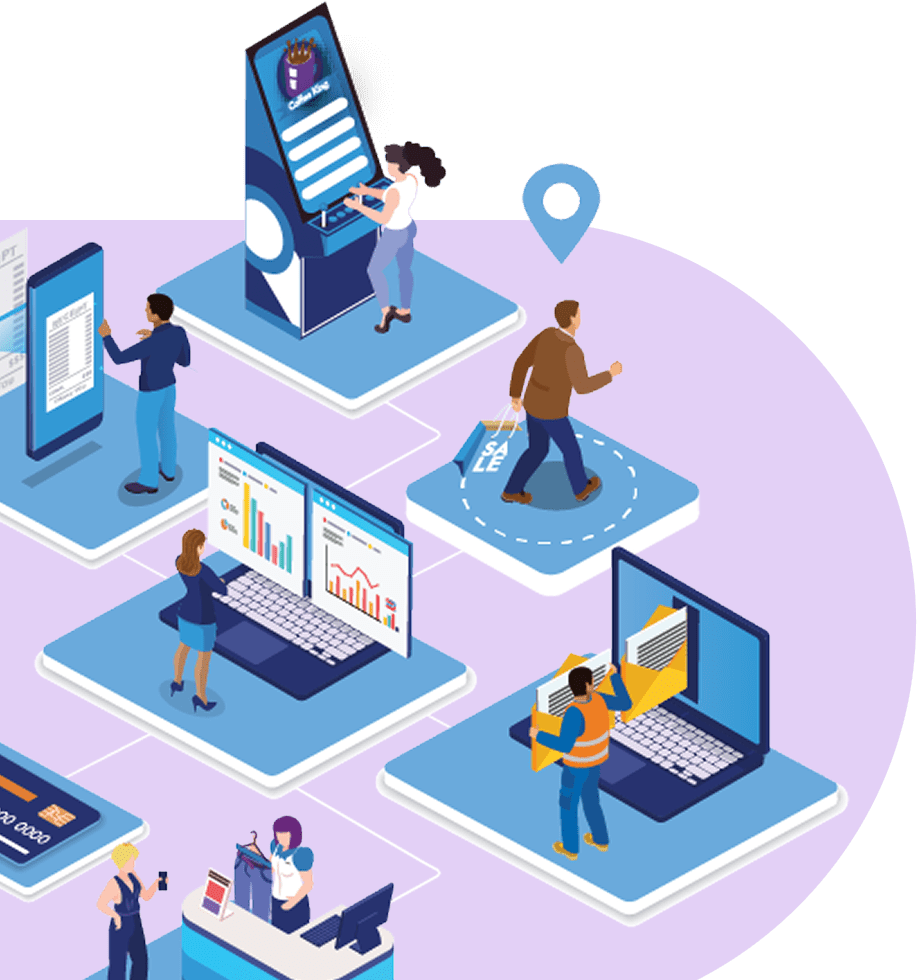

AI & LLMs = The Future of In-Mall Experiences. Learn how to leverage this technology to benefit your shoppers! Read the white paper
October 4, 2021 • 10 min read

Coniq is the leading Loyalty, CRM, and customer engagement provider, powering programs for many of the world's leading retail destinations. Today we use our expertise to analyze key elements required to create a market-leading loyalty program.
Looking at your loyalty proposition through your customer's eyes is fundamental if you want to deliver a mall loyalty program that attracts many customers and keeps engaging them over time.
There are several factors to consider here; Firstly, what are the benefits of joining? Do you have a simple, easy-to-understand loyalty mechanic? Is it clear how you earn points and how you can redeem them?
Secondly, Are you clear on how you use the data, and is it a fair exchange for the program's rewards? People are increasingly protective of their data, so there should be clearly articulated reasons why customers should give their details and what you will do with the data.
Thirdly, how can my retail loyalty program improve the customer experience? Malls today develop a plethora of services, such as hands-free shopping, carry to car, cloakroom services, or pre-bookable parking spaces. Look to how the program can remove obstacles for guests as part of the program, be they international tourists wanting a VAT refund or someone who wants to book their car in for valeting while they shop.
Finally, Friction - How easy is it to join? Can I sign up in-center, in-store, online, on social, or on an app? Are you initially asking for too much information or too many mandatory fields? Each hurdle to sign up dramatically reduces the number of people who become members, so if your program adds friction rather than removing it, review and modify your program.
Different customer demographics have different attitudes to saving and spending points. However, at some point, every person wants to be rewarded for their loyalty, which involves redemption.
In our experience is that there are several golden rules to remember:
Visitors to your shopping mall are a result of marketing investment, and customers who are actively spending are at their most highly engaged - don't miss the opportunity to drive incremental sales and build brand loyalty by sending relevant offers and rewards immediately.
Credit customers points as soon as they have earned them. Loyalty programs where you credit points immediately often find the customers redeem them in the next shop they visit or even visit another shop specifically to spend them; choose a solution that allows you to reward your customers in real-time.
Have a simple exchange rate. The best performing schemes in the industry have points with a clear value: For example, 10 points = 1 Dollar. Make it as simple as possible for customers to work out exactly what they have earned and what they are therefore entitled to. No one wants a disappointed customer who assumed they had a bigger reward waiting for them than is actually available.
Coniq has conducted significant research into the value of customers to a shopping center. The analysis of Full Price Shopping Centers and those Customers shopping at Outlets are surprisingly similar; The findings consistently show that a small number of customers are responsible for a disproportionately high amount of spend.
The top 10% of customers will contribute approximately a third of all spend, and the next 25% approximately another third. The net result is that a center is heavily reliant on a third of its audience, and the impact of their visits are disproportionately important to a center's success – driving more visits with this audience directly benefits turnover. If you lose their loyalty, the reverse applies.
Segmentation allows you to identify these most valuable customers, direct your marketing budget towards them, and create content encouraging specific behaviors that drive mall performance and Marketing ROI.
Being able to monitor and track shopper behavior allows for constant optimization of your communication when the best time is to target which segments and which offers are most effective. Once you achieve a baseline of success, you are then in a much stronger position to experiment with minimal risk to your revenue.
Social Media is a powerful influencer for many consumer groups, and getting customers to act as an extension of your marketing team can reap significant benefits; Rewarding customers for sharing posts, checking in, or giving feedback creates stronger engagement and amplifies your message among similar demographics to your existing visitors.
Also, social sign-up is a frictionless sign-up tool that consistently boosts recruitment. While the level of information you may receive about a customer can be less, you then have the opportunity to get to know more about them. Two pieces of excellent research have recently identified that people who shop at a physical store also spend significantly more with that retailer online: Both ICSC and CACI researched the relationship, and both dubbed it The Halo Effect; the most innovative outlet centers are already creating online marketplaces to help retailers sell products online and are pioneering ways to reward customers with loyalty points for both their online and their in-store purchases.
The golden rule here is Automate whenever possible - Technology already exists that makes it possible to provide a rich customer experience using automation.
Take time to map key customer journeys and automate as many of these as possible – from welcome emails to rewards for first transactions, reaching spending milestones, or just surprising your customers; automating these journeys saves time and resources, allowing your marketing team to focus on the insights that drive further spend and engagement.
For large loyalty programs, the challenge is that every consumer wants a personalized experience - but they all want it simultaneously. Automation helps to ensure consumers receive relevant, segmented content at exactly the right time.
As technology progresses, machine learning will take the place of trend spotting. As machines can process far better and faster, AI will allow for even more relevant communications and updates to be sent out with less human interaction. AI-enabled loyalty solutions will help create "Micro-segments" - small groups with similar consumer behaviors which human analysis would struggle to identify; the results will be a richer, more personalized experience on a member-by-member basis.
Everyone loves surprises, and brands that create the strongest emotional connections with their customers are the ones that consistently mix offers with rewards.
Surprise and Delight offers act as powerful "nudges," driving customers to re-visit and buy more. For the retailer, this translates into engaged and high-spending customers. Coniq clients who use this strategy in their loyalty programs often report a 25% increase in spend among the members.
90% of purchase decisions are emotion-driven, and Surprise and Delight rewards hit a sweet spot on the gratification chart. Customers given covert rewards are also more likely to share and recommend the business to their peers.
Action-linked Surprise and Delight rewards enhance post-purchase experience and reinforce desirable shopping behavior. It's also a great way to gamify the shopping experience and keep customers interested and motivated. Shoppers who receive covert offers feel in control and rewarded for their actions. And because people like to repeat behaviors that generate positive reactions, they shop again, spending more as a result.
Apps are a great way to ensure your brand is always in your customer's hand. For organizations with multiple shopping centers, they can have a general design layout for each mall, so economies of scale come into play. Innovations such as customer engagement programs that provide AaaS (App as a Service) also allow you to benefit from new feature releases for a low monthly fee.
Mobile apps also introduce the opportunity to incorporate push notifications and Geo-location into your marketing mix, ensuring you can welcome every customer individually on arrival and then serve them relevant content in real-time during their shopping visit.
Consumers also want choice, and while physical loyalty cards are a powerful recruitment tool, by offering a card that can be stored in a phone's wallet, customers will always have the program to hand and be able to participate in the shopping mall loyalty program.
Whether it is GDPR in Europe or a US data privacy equivalent, handling of consumer data is not all about record-breaking fines and compliance processes; At the same time, the days of running a competition in a mall and inputting information onto a spreadsheet are long gone, GDPR provides an excellent opportunity to define how your organization uses customer data.
The best players in the sector are using GDPR to review and redefine how data can be used to improve the shopping experience, how to strengthen the relationship with the customer, and how to differentiate the organization from its competitors.
People are becoming increasingly wary about sharing personal data. A clear privacy policy showing exactly how you use their data will and held and how they can both access and delete their data is essential. However tempting it might be, never over-email your members, and ensure you have an easy-to-use and effective unsubscribe process - making it hard to leave will not prevent unsubscription. Still, it may harm the relationship with your brand!
A successful mall loyalty program must have a minimum of 60% of retailers actively engaged in the program. It shouldn't be underestimated how much effort is required to continually engage retailers, source rewards and offers, plus update them on key insights from the rewards program.
Retailers are your customers too, and engaging them is critical to your business's success. If you don't have the resources available internally, seek the services of a brand engagement agency to foster that relationship on your behalf.
Retailers are often passionate about their own loyalty programs. However, consumers visit malls for the variety and choice - a program that rewards loyalty with the mall, and loyalty with a specific retailer allows a consumer to feel rewarded while providing the retailer with data they can only access through participation in the shopping mall loyalty program.
The ability for a retailer to understand their performance against peers or across their portfolio introduces valuable, previously unavailable insight and paves the way for new areas of partnership between the mall and the retailer, such as triggered advertising or analyzing demographic fit in a potential new mall.
No matter what the strategic objectives of your loyalty program, one of the most powerful benefits of the program will be the customer data. The best programs have a clear strategy on how they will use the data to create a competitive advantage.
Leading mall loyalty programs not only compare each shopping center's performance against peers in the portfolio but also use data to inform marketing strategies, such as tourism advertising spend, channel performance, and campaign ROI. Loyalty programs allow you to assess ROI by comparing actual spend in the center against marketing investment. The best-in-class programs are also using the data to build stronger collaborations with their retailers, allowing them to compare their stores against center averages or against their own stores in a portfolio. Data sharing is a trend that will only continue, and will be a crucial differentiator for retailers when choosing which mall operators to take leases with.
With retail undergoing seismic changes, it is unsurprising that many organizations are also growing their insight and innovation teams to explore how to capitalize on customer data to inform future strategy. For example, how AI can interrogate this data to identify changing consumer behaviors or trends earlier.
As business models evolve and consumer behaviors change, creating a world-class loyalty program will be a key strategy for a better understanding of business drivers that will define tomorrow's market leaders.
Are you attending ICSC Las Vegas, Recon Mena, or Mapic this year? Catch up over a coffee with us to find out the latest news in retail loyalty. Contact us today.
